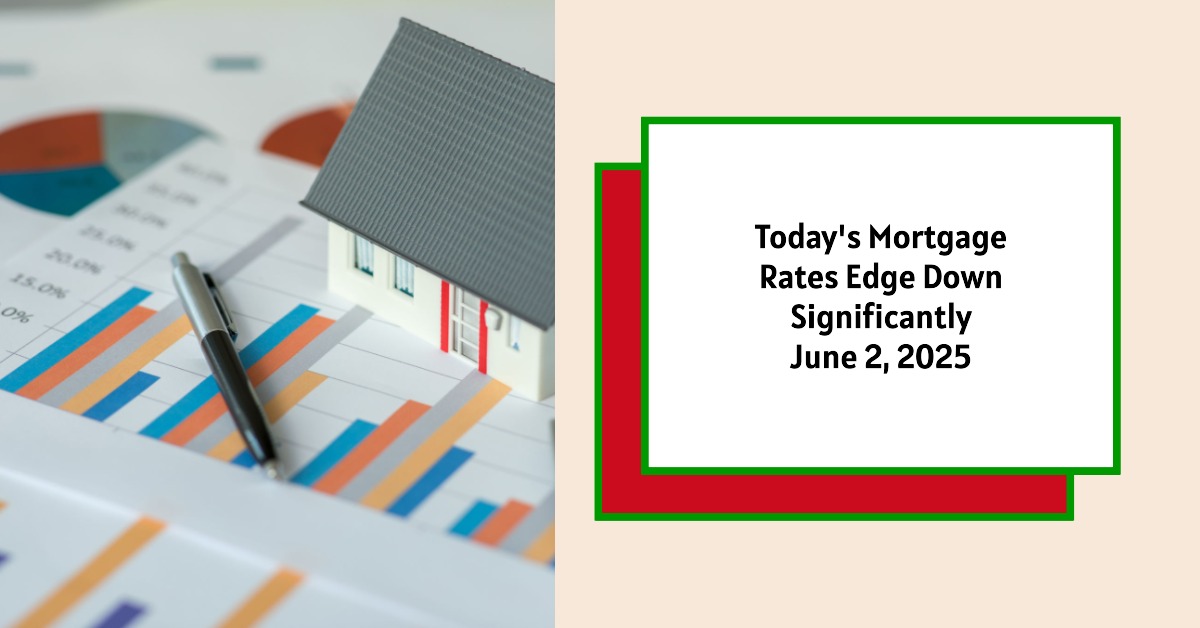As of June 2, 2025, the national average for the 30-year fixed mortgage rate has slightly decreased to 6.95%. This minor dip follows a larger decrease observed over the past week. For homeowners considering a change, the national average for the 30-year fixed refinance rate has also seen a notable drop to 7.18%. Keeping a close eye on these mortgage rate trends and refinance rate trends is crucial for anyone looking to buy a home or adjust their current mortgage.
Today's Mortgage Rates – June 2, 2025: Rates Edge Down Significantly
Key Takeaways:
- 30-year fixed mortgage rates are currently averaging 6.95%, a slight decrease today and a more significant decrease over the past week.
- The 15-year fixed mortgage rate remains stable at 6.02%.
- 5-year ARM mortgage rates have increased to 7.39%.
- The national average for the 30-year fixed refinance rate has fallen to 7.18%.
- The 15-year fixed refinance rate has decreased to 6.04%.
- The 5-year ARM refinance rate is currently at 6.00%.
Let's delve deeper into the specifics of today's mortgage rates and today's refinance rates.
Current Mortgage Rate Overview
For individuals looking to purchase a home, understanding the different types of mortgage interest rates available is essential. The most common types are fixed-rate mortgages and adjustable-rate mortgages (ARMs). Fixed-rate mortgages, like the popular 30-year and 15-year options, offer a consistent interest rate throughout the life of the loan, providing predictability in monthly payments. On the other hand, ARMs have an initial fixed interest rate period, after which the rate adjusts periodically based on market conditions.
According to the latest data from Zillow, as of Monday, June 2, 2025, the national averages for various mortgage types are as follows:
National Average Mortgage Rates – June 2, 2025
| Loan Program | Rate | 1-Week Change | APR | 1-Week Change |
|---|---|---|---|---|
| 30-Year Fixed Rate | 6.95% | Down 0.06% | 7.41% | Down 0.07% |
| 15-Year Fixed Rate | 6.02% | Down 0.04% | 6.32% | Down 0.05% |
| 5-Year ARM | 7.39% | Up 0.07% | 7.92% | Down 0.04% |
As you can see, the 30-year fixed mortgage rate has moved slightly downward. This is welcome news for prospective homebuyers who may have been waiting for a slight easing in borrowing costs. The stability in the 15-year fixed mortgage rate offers another reliable option for those looking for a shorter loan term and typically lower overall interest paid. However, the increase in the 5-year ARM mortgage rate suggests that the initial lower rate that ARMs offer might be coming with a slightly higher immediate cost.
It's interesting to observe these small shifts in rates. Even minor changes can impact the affordability of a home, especially when considering the long-term nature of a mortgage. For instance, on a $300,000 loan, a 0.02% decrease in the interest rate on a 30-year fixed mortgage can translate to a savings of roughly $10-$15 per month in the principal and interest payment. Over the 30-year term, this seemingly small difference can add up to thousands of dollars.
Looking back at the past 90 days, we can see some interesting movement in these rates for a purchase with a credit score of 740 or higher and a 20% or higher loan-to-value ratio:
90-Day Trend of 5-Year ARM Purchase Rates
| Date | Percent Interest Rate | Annual Percentage Rate |
|---|---|---|
| March 4, 2025 | 5.973% | 6.886% |
| April 2, 2025 | 6.564% | 7.020% |
| May 2, 2025 | 6.923% | 7.165% |
| June 2, 2025 | 6.879% | 7.130% |
90-Day Trend of 15-Year Fixed Purchase Rates
| Date | Percent Interest Rate | Annual Percentage Rate |
|---|---|---|
| March 4, 2025 | 5.487% | 5.611% |
| April 2, 2025 | 5.872% | 5.883% |
| May 2, 2025 | 5.976% | 5.985% |
| June 2, 2025 | 6.008% | 6.014% |
90-Day Trend of 30-Year Fixed Purchase Rates
| Date | Percent Interest Rate | Annual Percentage Rate |
|---|---|---|
| March 4, 2025 | 6.200% | 6.272% |
| April 2, 2025 | 6.498% | 6.503% |
| May 2, 2025 | 6.712% | 6.717% |
| June 2, 2025 | 6.779% | 6.783% |
These tables illustrate the fluctuations that can occur within a relatively short period. The 30-year fixed rate, for example, has shown a clear upward trend over the past three months, although we are seeing a slight dip today. The 15-year fixed rate has also generally increased, while the 5-year ARM has experienced more volatility.
Understanding Refinance Rates Today
For current homeowners, the decision to refinance their mortgage depends on a variety of factors, with prevailing refinance interest rates being a primary consideration. Refinancing involves taking out a new mortgage to pay off an existing one, potentially to secure a lower interest rate, change the loan term, or access cash.
According to Zillow's data from June 2, 2025, the national averages for common refinance loan types are as follows:
National Average Refinance Rates – June 2, 2025
| Loan Program | Rate | 1-Week Change |
|---|---|---|
| 30-Year Fixed Rate | 7.18% | Down 0.08% |
| 15-Year Fixed Rate | 6.04% | Down 0.04% |
| 5-Year ARM | 6.00% | No Change |
It's notable that the 30-year fixed refinance rate has seen a more significant decrease compared to the purchase mortgage rates. This might create an opportunity for homeowners who are looking to lower their monthly payments or reduce the total interest paid over the life of their loan. The small decrease in the 15-year fixed refinance rate could be attractive to those wanting to pay off their mortgage faster. The stable 5-year ARM refinance rate provides an option for those comfortable with potential future rate adjustments.
Read More:
Mortgage Rates Trends as of June 1, 2025
Dave Ramsey Predicts Mortgage Rates Will Probably Drop Soon in 2025
The decision of whether or not to refinance often hinges on the “break-even point,” which is the time it takes for the savings from the lower monthly payment to outweigh the costs associated with refinancing (such as appraisal fees, closing costs, etc.).
Consider a homeowner who took out a 30-year fixed mortgage for $250,000 five years ago at an interest rate of 4.5%. Their current monthly principal and interest payment is approximately $1,267. Now, if they were to refinance into a new 30-year fixed mortgage at today's average rate of 7.18%, their new monthly payment would be around $1,693. In this scenario, even with the recent drop in refinance rates, it might not be financially beneficial unless their original rate was significantly higher or their goals were different (like shortening the loan term).
However, let's consider another example. Suppose a homeowner has a remaining balance of $200,000 on a 30-year fixed mortgage they took out at 6% ten years ago. Their current monthly payment is roughly $1,199. If they can refinance into a new 20-year fixed mortgage (since they've already paid for 10 years) at an interest rate of, say, 5.5% (these are illustrative and not based on the provided refinance data, which doesn't include 20-year fixed refinance rates), their new monthly payment would be around $1,378. While the monthly payment is slightly higher, they would save significantly on total interest paid and shorten their loan term by 10 years.
It's always a good idea to use a mortgage refinance calculator to see how different rates and loan terms would impact your specific financial situation.
Factors Influencing Mortgage and Refinance Rates
Today's mortgage rates and today's refinance rates are influenced by a complex interplay of economic factors. These include:
- The Federal Reserve's monetary policy: Actions taken by the Fed, such as adjusting the federal funds rate, can indirectly influence mortgage rates.
- The health of the U.S. economy: Factors like job growth, inflation, and consumer confidence can impact investor behavior and bond yields, which often move in tandem with mortgage rates.
- The bond market: Mortgage rates are closely tied to the yield on U.S. Treasury bonds, particularly the 10-year Treasury note.
- Investor demand for mortgage-backed securities: The supply and demand for these securities, which bundle mortgages together for sale to investors, can affect rates.
It is my understanding that predicting the future direction of mortgage rates is challenging, as these economic indicators can be quite dynamic. However, staying informed about these underlying factors can help individuals make more educated decisions about when to buy or refinance.
Invest Smarter in a High-Rate Environment
With mortgage rates remaining elevated this year, it's more important than ever to focus on cash-flowing investment properties in strong rental markets.
Norada helps investors like you identify turnkey real estate deals that deliver predictable returns—even when borrowing costs are high.
HOT NEW LISTINGS JUST ADDED!
Connect with a Norada investment counselor today (No Obligation):
(800) 611-3060
Also Read:
- Will Mortgage Rates Go Down in 2025: Morgan Stanley's Forecast
- Expect High Mortgage Rates Until 2026: Fannie Mae's 2-Year Forecast
- Mortgage Rate Predictions 2025 from 4 Leading Housing Experts
- Mortgage Rates Forecast for the Next 3 Years: 2025 to 2027
- 30-Year Mortgage Rate Forecast for the Next 5 Years
- 15-Year Mortgage Rate Forecast for the Next 5 Years
- Why Are Mortgage Rates Going Up in 2025: Will Rates Drop?
- Why Are Mortgage Rates So High and Predictions for 2025
- Will Mortgage Rates Ever Be 3% Again in the Future?
- Mortgage Rates Predictions for Next 2 Years
- Mortgage Rate Predictions for Next 5 Years
- Mortgage Rate Predictions: Why 2% and 3% Rates are Out of Reach
- How Lower Mortgage Rates Can Save You Thousands?
- How to Get a Low Mortgage Interest Rate?
- Will Mortgage Rates Ever Be 4% Again?


